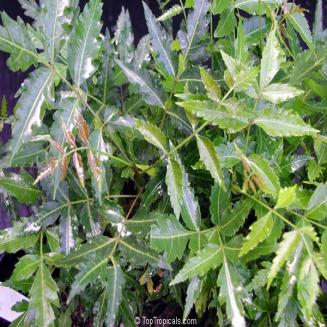
Code: MAL
|
:
|
English names: Margosa tree, China berry, Barbados lilac, pride of India, Persian lilac, bead tree, hoop tree.
Description: A tree 10m. high or more. Bark pale-brown, lenticellate, longitudinally furrowed. Leaves alternate, odd-pinnate; leaflets opposite, serrate, glabrous on both sides. Inflorescence in axillary or terminal biparous cyme; flowers white-lilac. Drupe ovate or ellipsoid-globose with 4 seeds, yellow when ripe.
Flowering period: March - April.
Distribution: Cultivated everywhere for wood.
Parts used: Root-bark, collected from the trees when they reach 7-8 years of age. The bark is scraped to remove the outside black skin, then dried in the sun or in ovens.
Chemical composition: The stem-bark and root-bark contain the alkaloid azaridine (margosine), sterols and tannins. The leaves yield the alkaloid paraisine and the flavonoid rutin. The seeds are rich in fatty oil consisting of stearic, palmitic, oleic and linoleic acids.
Therapeutic uses: The internal silky layer of the torrefied root-bark is used in treating ascariasis and oxyuriasis; it is less toxic than the trunk bark. The usual dose for adults is 2 to 3g per day, for 3 days, and for children, according to their age, 0.1 to 1.5g per day. Vaginal injection of the decoction is effective for trichomonas infections. Precautions must be taken because of the drug’s high toxicity.
